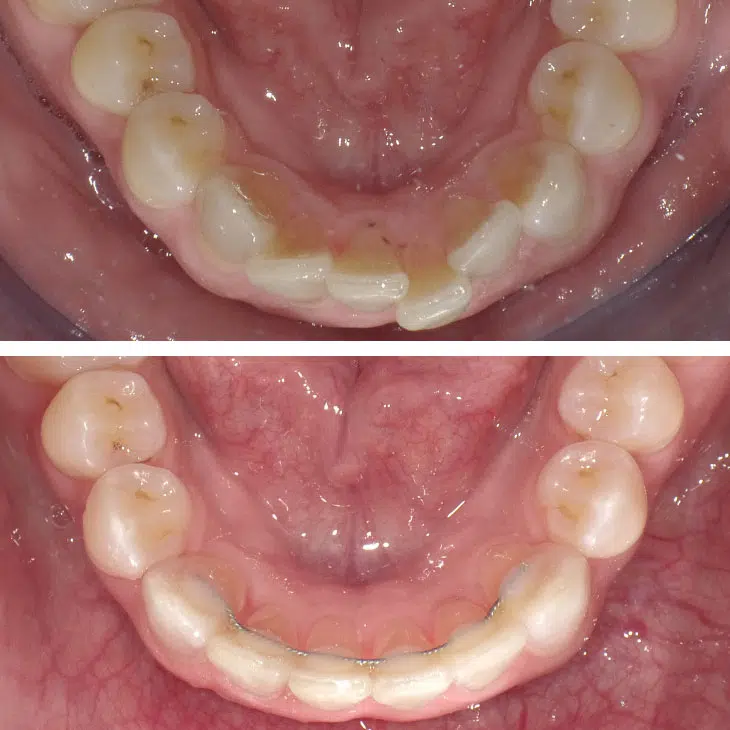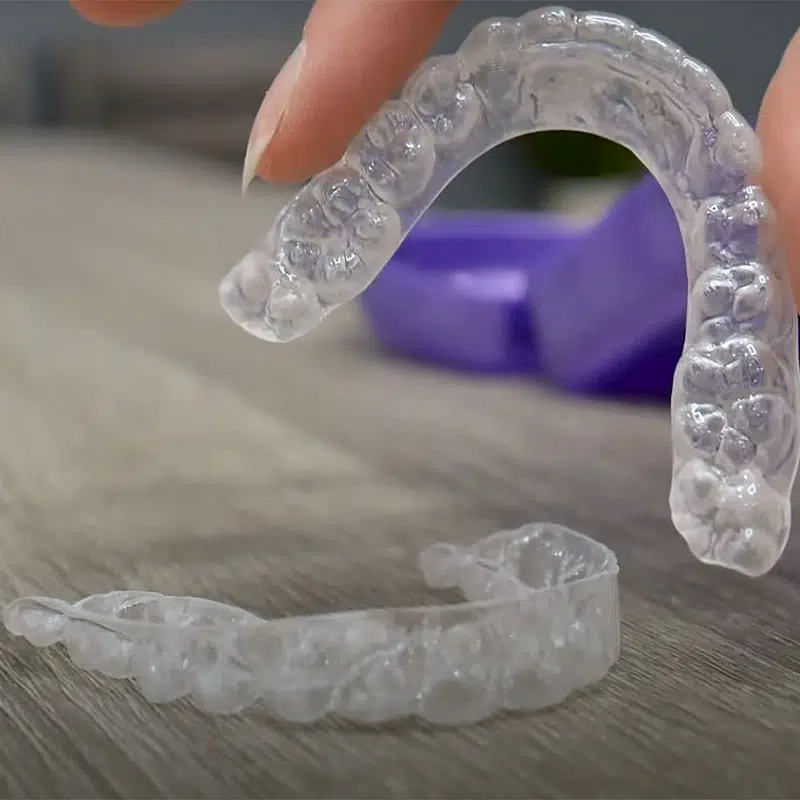Orthodontic Retainer Specialists

Congratulations! You made it through your entire orthodontic treatment and now have a perfectly straight smile that you are proud to show off. To keep your new smile as straight as possible and to protect your investment in yourself, it is vital that you continue to wear your orthodontic retainer. Retainers are custom-made orthodontic appliances often prescribed after orthodontic treatment to keep your teeth in place after correcting and reshaping is complete. While retainers can be bothersome, it’s a small price to pay compared to the cost of braces all over again.
At Gibbs Orthodontic Associates, well-known orthodontic specialists in NYC on the Upper East Side offer the newest, high-quality permanent, fixed, and removable dental retainers.
Why It’s Important to Wear a Retainer?
Wearing a retainer is generally the last part of orthodontic treatment and your dentist will provide you with your retainer once your braces are removed or when you have finished using removable braces such as aligners. At this stage your teeth should be beautifully straight in the positions planned by your orthodontist. However, the “memory” of where your teeth used to be situated will remain. This isn’t so surprising when you consider your teeth and tooth roots will have been moved through your jawbone.
By wearing a retainer, you can ensure your teeth remain stable and in the correct positions as they settle down after treatment. Initially, your dentist may suggest you wear your retainer all the time, gradually reducing the time required until you only need to wear it overnight. This depends on whether you have a removable or fixed retainer.
Fixed Retainers

A fixed retainer can be very useful for anybody concerned that they may otherwise forget to wear their retainer. It is usually just a very discreet, very thin piece of wire that is bonded onto the inner surfaces of your teeth with a cement similar to that used to bond brace brackets onto teeth.
Remember to keep a fixed retainer meticulously clean because the wire will stretch over several teeth.
Cleaning fixed retainers. You will need to use a floss threader or another cleaning device to make sure you can thoroughly clean in between each tooth, preventing tooth decay and the risk of gum disease. If you have worn fixed braces, then you should already be familiar with the technique for keeping your teeth clean. The extra care required to maintain fixed retainers can put some people off, but it’s worth bearing in mind that they do provide an excellent outcome and will keep your teeth perfectly straight.
Removable Retainers
There are several types of removable retainers:
- Retainers with a wire that goes across the front of the teeth and which is held in place with an acrylic plate and clasps that fit around the back teeth
- Retainers made from clear plastic that form a tight and nearly invisible skin over your teeth. These retainers look a little like tooth whitening trays or the clear aligners used by popular orthodontic systems such as Invisalign.

Having a removable retainer can be very appealing because they are so easy to use and to keep clean. However, because they are removable, they can be easier to damage or mislay and can be expensive to replace or repair.
If you have a dog, you must store your retainer well out of reach since dogs are attracted to the smell of saliva on dental appliances and have an unfortunate tendency to chew them. Dogs have destroyed many retainers! Initially, your dentist may want you to wear your removable retainer all the time, day and night, for the first three months or more, and they will need to assess the position of your teeth after this time. If your orthodontist cannot see any movement, you can reduce this time to just a few hours each day or overnight.
Your Removable Retainers Can Be Invisible too!
Just like your invisible braces, your retainers can be equally discreet or may only need to be worn for a short while each day. Usually, retainers must be worn all or nearly all the time immediately after treatment is completed. It’s important to realize that during this time the bone around the teeth that have moved during treatment is remodeling and it must be given a chance to grow strongly around the tooth, holding it firmly in its new position. If you don’t wear your retainers until the bone has remodeled, there’s a strong chance that your teeth will begin to shift back to their original positions.
Your retainers look very similar to Invisalign aligners, are made from the same strong plastic material, and are very discreet. Alternatively, another solution is to have a thin metal wire bonded onto the inner surfaces of the teeth that have moved, which will ensure they cannot move.
Maintaining Your Retainer
Whichever type of retainer you choose, you need to regularly maintain it to ensure it continues to fit correctly and is properly retaining your teeth.
If you have a fixed retainer, then routine checkups and cleanings allow your hygienist to professionally clean the retainer and your teeth while checking for any signs of cavities or gum disease. They will also check it is still properly secured in place.
If you have a removable retainer, then your dentist will check its condition and the fit in your mouth and if necessary can professionally clean it. They can also offer advice on how to keep it clean at home.
Removable retainers should never be brushed with toothpaste since this can abrade acrylic. Instead, you can use denture cleaning tablets or a good antibacterial mouth rinse to keep it clean. A simple solution of vinegar and water will also help keep your retainer free from bacteria.
Even though it might seem a lot of effort to wear a retainer, you probably spent a significant sum of money on straightening your teeth and your retainer will protect your investment and your smile. It is also worth remembering all the benefits of teeth straightening, as you have probably noticed your teeth are easier to keep clean which will help to reduce your risk of tooth decay and gum disease. Over the longer term this could help to reduce your dental costs. Having a healthy smile also protects your general health.
Clinical studies are increasingly discovering the links between poor oral health and serious health conditions including heart disease, diabetes and rheumatoid arthritis, as well as some cancers. With orthodontic treatment, you can look forward to having a beautifully healthy and attractive smile and with retainers it can last for life.
How Do I Clean My Retainer?
After each meal, take out your retainer and wash it as best as you can. Use your toothbrush and toothpaste to brush all surfaces of the appliance, then rinse with cool water. Never rinse your retainer in hot water.
If your retainer picks up flavors or odors from foods you may soak it in mouthwash or use cleaning tablets such as Retainer Brite. Retainer cleaners such as these should be used NO MORE THAN once a week.
How to Clean Your Retainer With Retainer Brite:
- Drop one tablet into warm water
- Place appliance in blue solution
- Leave appliance in solution for 3-5 minutes only
- Rinse appliance thoroughly
How to Clean Retainers – Tips from Dr. Gibbs
How Do I Store My Retainer?
You should take precautions to properly store your new retainer and avoid damaging or losing it. It’s an expensive piece of equipment and is vital to keep your smile straight. When you aren’t wearing your retainer you should:
- Store it in the case provided by your NYC Orthodontist or Dr. Gibbs. An unprotected retainer can easily be damaged and you will face replacement and repair fees. So do yourself and your bank account a favor and always use the approved storage case.
- Never shove them in your pockets or backpack or drop them in your purse. Retainers can break easily.
- Avoid wrapping your retainer in napkins while eating. A retainer often ends up in the trash when you wrap them in napkins. If you place your retainer n your pocket, you will likely forget about it. Nothing destroys a retainer faster than a trip through the washer and dryer!
Caring For Your Bonded Lingual Retainer
If we have placed a glued wire behind your lower front teeth this will be your permanent retainer. We place this type of retainer to reduce the possibility of relapse. If you decide to have this retainer removed, we will recommend that a removable retainer be made in order to maintain the position of the teeth.
Foods To Avoid While Wearing a Retainer
Hard, sticky and very chewy foods should be avoided. It is acceptable to eat them if you can cut them into small pieces.
DO NOT BITE INTO APPLES, CARROTS, CELERY, NUTS, PIZZA CRUST and other hard foods. Although the wire is glued in, it can still break. If the wire and/or glue breaks your teeth could shift. Please be very careful and be vigilant about what you eat.
We have shown you how to floss with the floss threader and special floss. Please follow our instructions carefully to avoid any periodontal (gum) disease or caries. If we (or your general dentist) find that you are unable to maintain good oral hygiene with the bonded retainer we may remove it and give you a removable retainer
If the wire and /or glue are broken or loose please call the office as soon as possible. We will try to get a sense of what is broken on the phone since the time needed to repair it can vary greatly. Please be advised that repairs and remakes of the permanent retainer will incur a charge.
You have worked very hard for your beautiful smile, please be careful with your retainers!!!
If you have any questions concerning retainer wear or other orthodontics needs, please contact our orthodontic office in NYC.
Do you have any questions about the retainers? To schedule a consultation, or if you would like to meet with Dr. Gibbs and his team of orthodontic retainer specialists, please call us at (212) 535-4111.















